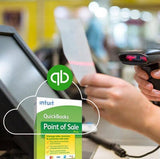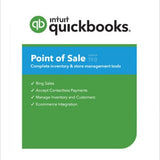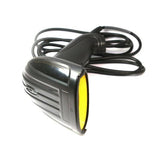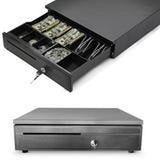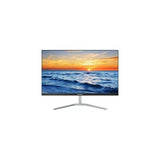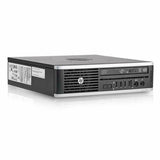Complete QuickBooks Retail Point of Sale POS Cash Register Bundle with 22" HD Monitor
- NO monthly fees
-
FREE SHIPPING
(continental USA and Canadian Provinces) -
$250 Rebate off complete POS System Bundles & Free Credit Card Reader
(with new merchant account application and 1 year activation with PointOfSalePOS.com)
Bundle Includes:
-
- USFF small form computer
(used - off lease refurbished) - New 22" Full HD Monitor
- New iPOSx cash drawer with auto kick out receipt printer interface
- New iPOSx thermal receipt printer
- New iPOSx handheld laser barcode scanner
-
New Intuit QuickBooks retail point of sale cash register basic software
- New keyboard & mouse
-
1 Year Warranty
- 30 Day Return Period
- Free Shipping
- USFF small form computer
Optional:
A QuickBooks POS system (Point of Sale) is a retail management system developed by Intuit, the makers of QuickBooks accounting software. It combines POS functionality with seamless integration into QuickBooks accounting, making it easier for small to medium-sized businesses to manage sales, inventory, customers, and financial data all in one place.
Key Features and Functionality of QuickBooks POS System:
-
Sales Management:
-
The QuickBooks POS allows businesses to process sales transactions quickly and accurately. You can use barcode scanners, receipt printers, and cash drawers to complete sales.
-
Payments: It supports multiple payment methods, including cash, credit/debit cards, checks, and even mobile payments (depending on the configuration).
-
-
Inventory Management:
-
One of the key features of QuickBooks POS is its inventory management capabilities. It helps businesses keep track of product quantities, manage stock levels, and reorder products when inventory is low.
-
The system can automatically update stock levels as items are sold or returned.
-
You can also track serial numbers or lot numbers for better product traceability.
-
-
Customer Management:
-
The QuickBooks POS allows businesses to create and manage customer profiles, which include purchase history, contact information, and loyalty programs.
-
Businesses can track customer purchases, manage discounts or rewards, and offer personalized promotions based on customer preferences.
-
-
Receipt and Report Generation:
-
The system generates receipts for customers after each transaction, and it can email receipts directly to customers as well.
-
It also offers a range of reports including sales reports, inventory reports, and customer purchase history, helping business owners gain insights into their operations and make informed decisions.
-
-
Employee Management:
-
QuickBooks POS allows businesses to track employee sales performance and hours worked. It helps in managing employee schedules, setting up different user roles (e.g., cashier, manager), and protecting sensitive data by assigning permissions to various employees.
-
-
Integration with QuickBooks Accounting Software:
-
One of the most significant advantages of QuickBooks POS is its integration with QuickBooks accounting software. This integration ensures that sales data, inventory changes, and customer information sync seamlessly with the accounting records.
-
This eliminates the need for manual data entry, reducing the chances of errors, and allows for real-time updates to financial data.
-
Businesses can automatically generate financial statements such as profit and loss reports, balance sheets, and tax reports, helping to streamline bookkeeping tasks.
-
-
Returns and Exchanges:
-
QuickBooks POS handles returns and exchanges, tracking the inventory updates when an item is returned and ensuring that the customer is credited appropriately.
-
Returns can be processed by scanning the original transaction or searching by customer information.
-
-
Hardware Compatibility:
-
The QuickBooks POS system is compatible with a variety of POS hardware such as barcode scanners, receipt printers, cash drawers, and label printers.
-
It works on both Windows-based devices and, in some cases, can be accessed through mobile devices or tablets, depending on the version used.
-
How QuickBooks POS Works:
-
Setting Up:
-
Once set up, the system is ready to manage transactions, track inventory, and generate reports. The user can input products, assign prices, set up payment methods, and create customer profiles.
-
-
Sales Transactions:
-
When a customer makes a purchase, the cashier or salesperson scans the item(s) using a barcode scanner or manually enters the product details. The system calculates the total cost, including applicable taxes, and prompts for payment.
-
After payment is processed, the system updates the inventory in real time, generates a receipt, and updates the accounting data in QuickBooks automatically.
-
-
Inventory Tracking:
-
As sales are processed, the inventory is automatically adjusted. The system provides notifications when stock is running low and allows users to place orders for new stock from suppliers.
-
-
End-of-Day Reconciliation:
-
At the end of the day, QuickBooks POS can provide end-of-day reports for cashiers, including total sales, cash drawer balances, and any discrepancies. These reports can be used to reconcile the day's transactions.
-
-
Syncing with QuickBooks Accounting:
-
After transactions are completed, data synchronization ensures that the sales, customer data, and inventory updates are reflected in QuickBooks accounting software. This saves time by eliminating the need for manual entry and helps maintain accurate financial records.
-
Benefits of QuickBooks POS:
-
Seamless Integration: The direct integration with QuickBooks accounting software allows business owners to streamline their accounting and bookkeeping processes, saving time and reducing errors.
-
Real-Time Data Sync: QuickBooks POS keeps your financial data up to date in real-time. This allows you to generate financial reports quickly without having to manually update your books.
-
Inventory Management: The system tracks inventory levels automatically and provides alerts when stock is running low. It can also help with reordering, ensuring that you don’t run out of popular products.
-
Customizable Reports: QuickBooks POS generates a variety of reports that can help you monitor sales, manage inventory, and track customer activity, making it easier to make informed business decisions.
-
User-Friendly Interface: The system is designed to be easy to use for both business owners and employees, with an intuitive interface for managing products, transactions, and reports.
-
Loyalty Programs and Discounts: The POS system can be used to manage loyalty programs, discounts, and promotions, which can increase customer retention and sales.
How It Benefits Businesses:
-
Time Savings: By integrating with QuickBooks, the POS system automates tasks like financial reporting, inventory tracking, and customer management, reducing the amount of time spent on manual tasks.
-
Better Decision-Making: Access to real-time financial and sales reports allows business owners to make smarter decisions based on actual data, helping with inventory purchasing, pricing strategies, and marketing efforts.
-
Improved Customer Service: With customer purchase histories, businesses can offer personalized service, rewards programs, and promotions, improving customer satisfaction and loyalty.
-
Scalability: The system is scalable, so it can grow with your business, whether you’re a small store or a larger retail operation with multiple locations.
Conclusion:
A QuickBooks POS system is a powerful, user-friendly retail solution that integrates seamlessly with QuickBooks accounting software. It helps businesses manage sales, inventory, customer information, and payments all in one system while ensuring smooth synchronization with accounting records. This integration not only reduces errors but also saves time on bookkeeping, giving business owners valuable insights into their operations and improving efficiency. It's an ideal solution for small to medium-sized businesses looking to simplify their retail processes and streamline their financial management.









